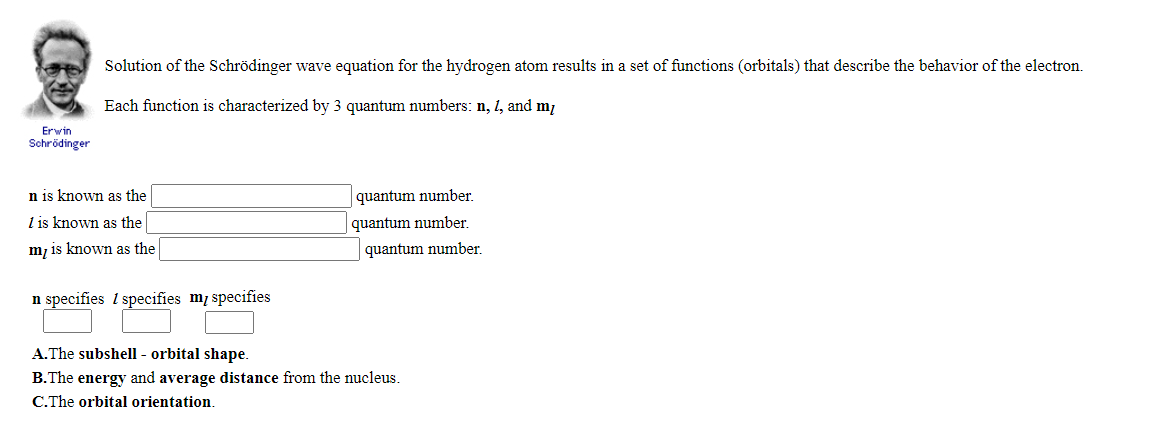Solution of the Schrödinger wave equation for the hydrogen atom results in a set of functions (orbitals) that describe the behavior of the electron. Each function is characterized by 3 quantum numbers: n, 1, and m Erwin Schrödinger n is known as the |quantum number. | quantum number. | quantum number. l is known as the m, is known as the n specifies i specifies mį specifies A.The subshell - orbital shape. B.The energy and average distance from the nucleus. C.The orbital orientation.
Solution of the Schrödinger wave equation for the hydrogen atom results in a set of functions (orbitals) that describe the behavior of the electron. Each function is characterized by 3 quantum numbers: n, 1, and m Erwin Schrödinger n is known as the |quantum number. | quantum number. | quantum number. l is known as the m, is known as the n specifies i specifies mį specifies A.The subshell - orbital shape. B.The energy and average distance from the nucleus. C.The orbital orientation.
Physical Chemistry
2nd Edition
ISBN:9781133958437
Author:Ball, David W. (david Warren), BAER, Tomas
Publisher:Ball, David W. (david Warren), BAER, Tomas
Chapter9: Pre-quantum Mechanics
Section: Chapter Questions
Problem 9.16E: Some scientists study Rydberg atoms, atoms whose electron has a large value of the n quantum number....
Related questions
Question

Transcribed Image Text:Solution of the Schrödinger wave equation for the hydrogen atom results in a set of functions (orbitals) that describe the behavior of the electron.
Each function is characterized by 3 quantum numbers: n, 1, and m,
Erwin
Schrödinger
n is known as the
quantum number.
l is known as the
quantum number.
m, is known as the
quantum number.
n specifies 1 specifies mį specifies
A.The subshell - orbital shape.
B.The energy and average distance from the nucleus.
C.The orbital orientation.

Transcribed Image Text:Solution of the Schrödinger wave equation for the hydrogen atom results in a set of functions (orbitals) that describe the behavior of the electron. Each function is characterized by three quantur
numbers: n, 1, and m.
If the value of n= 3
The quantum number I can have values from
to
The total number of orbitals possible at the n = 3 energy level is
If the value of 1= 3
The quantum number m, can have values from
The total number of orbitals possible at the 1= 3 sublevel is
to
Expert Solution
This question has been solved!
Explore an expertly crafted, step-by-step solution for a thorough understanding of key concepts.
This is a popular solution!
Trending now
This is a popular solution!
Step by step
Solved in 2 steps

Recommended textbooks for you

Physical Chemistry
Chemistry
ISBN:
9781133958437
Author:
Ball, David W. (david Warren), BAER, Tomas
Publisher:
Wadsworth Cengage Learning,

Chemistry: Principles and Reactions
Chemistry
ISBN:
9781305079373
Author:
William L. Masterton, Cecile N. Hurley
Publisher:
Cengage Learning

Principles of Modern Chemistry
Chemistry
ISBN:
9781305079113
Author:
David W. Oxtoby, H. Pat Gillis, Laurie J. Butler
Publisher:
Cengage Learning

Physical Chemistry
Chemistry
ISBN:
9781133958437
Author:
Ball, David W. (david Warren), BAER, Tomas
Publisher:
Wadsworth Cengage Learning,

Chemistry: Principles and Reactions
Chemistry
ISBN:
9781305079373
Author:
William L. Masterton, Cecile N. Hurley
Publisher:
Cengage Learning

Principles of Modern Chemistry
Chemistry
ISBN:
9781305079113
Author:
David W. Oxtoby, H. Pat Gillis, Laurie J. Butler
Publisher:
Cengage Learning

Chemistry: Principles and Practice
Chemistry
ISBN:
9780534420123
Author:
Daniel L. Reger, Scott R. Goode, David W. Ball, Edward Mercer
Publisher:
Cengage Learning

Chemistry: Matter and Change
Chemistry
ISBN:
9780078746376
Author:
Dinah Zike, Laurel Dingrando, Nicholas Hainen, Cheryl Wistrom
Publisher:
Glencoe/McGraw-Hill School Pub Co

Chemistry for Engineering Students
Chemistry
ISBN:
9781337398909
Author:
Lawrence S. Brown, Tom Holme
Publisher:
Cengage Learning